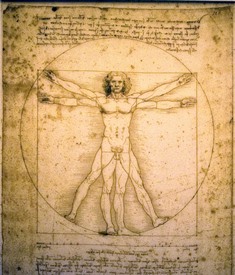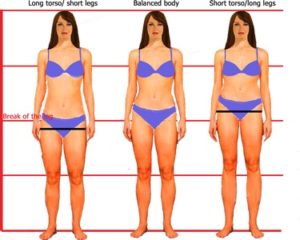Body Proportions – Musculoskeletal Pain – Sports Performance

The importance of knowing how tall we are is somewhat obvious. What is less obvious is the importance of knowing the proportionality of our vertical height. The ideal proportionality of a human body’s stature was defined by Leonardo da Vinci. The “Vitruvian Man” or “drawing of proportions of man” is the ideal human proportions based on geometry.
Da Vinci identified the ideal proportionality. Not all humans have ideal proportions. Some of us can be disproportioned. Understanding of the proportionality of the human body has importance to many areas. Portrait painters must know the rules of proportionality. The clothing fashion industry has methods of using clothing to alter the perception of body proportions. There is some evidence that certain horizontal body types, such as pear-shaped individuals have increasing risk for diabetes.
We cannot change our body structure and proportionality. However, self-awareness can improve our ability to identify opportunities and risks.
Fashion experts describe vertical classifications based on the “break of the legs”. The body can be balanced, proportionally long torso too short legs or proportionally long legs to the short torso.

Body Proportions can affect musculoskeletal pain:
When a person shorter than 5’4” comes into my clinic with a proportionally tall torso and short legs I expect they have or will have back or neck problems. Chairs are designed for individuals 5’4” or taller. Individuals with proportionally more torso or spine have a greater risk of developing back and neck problems. If legs are relatively short they do not reach the floor when sitting, and as compensation, the individual sits on the edge of the chair away from the chair's backrest, slumps into the chair to reach the backrest, or sits on their feet. Awareness of this disproportionality and risk for spine problems provides an opportunity to modify the chair and work environment to account for the relatively short legs.
Men who are long wasted (top of the pelvic bone is very close to the 12th rib) and relatively long legs are always going to have difficulty with the standard flexibility test of reaching for toes. The ribs bang into the tall pelvic bone, the relatively long legs, and short torso it is unreasonable to expect the fingers to reach the toes without compensating for it with excessive movement in the thoracic spine. This same individual will have difficulty with the fitness strength test of straight leg lift to strengthen the abdominal muscles. There is not enough mass in the torso to counterbalance when lifting the relatively long legs.
Shoes are made in 17 different lengths and 10 different widths. Tables are all made at one height 33”. The proportionate length of the thigh bone is highly variable in humans, yet the length of the seat pain in cars is only one size. All car seats slide fore and aft, but after that, the options to adjust the car seat can be someone limited. Generally, there is one size office chair. It may or may not have the ability to adjust the chair to match the wide variations of an individual’s vertical and horizontal proportions.
If you have odd vertical and horizontal proportions when selecting equipment such as car seats, office chairs, and bicycles look for the ability to adjust the equipment to match your odd proportions.
Body proportions can affect sports performance:
Parents can help guide children to choosing particular sporting activities by recognizing certain body types and proportions are better suited for certain sports. A few examples are as follows. Long torsos and short legs are advantageous for swimming. Long legs short torsos are advantageous for running. Short legs are advantageous for field hockey.



Bottom Line:
- Self-awareness of vertical proportionality can improve our ability to identify risks and opportunities.
- Generally, long torso relatively short legs are more prone to back and neck problems, and short torso and long legs are more prone to hip and knee problems.
- If your stature is vertically disproportionate be aware of your odd proportionality when selecting equipment, such as chairs, cars, and bicycles.
- Proportionality of vertical stature should be considered when applying standardized flexibility and strength tests.
Damien Howell Physical Therapy – 804-647-9499 – Fax: 866-879-8591 At-Home, At Office, At Fitness Facility I come to you, I do home visits Damien@damienhowellpt.com
